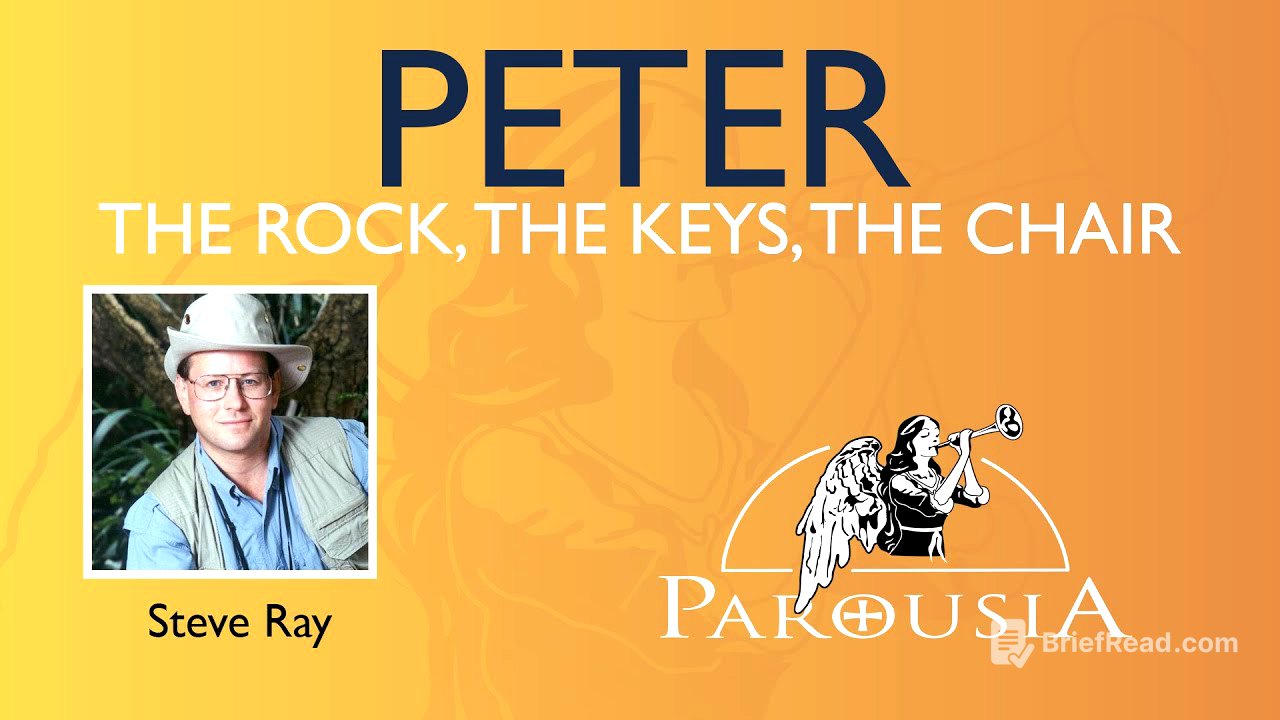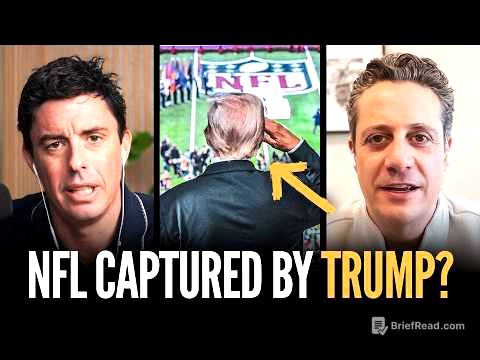TLDR;
In this YouTube video, Stephen Ray shares his journey from being an Evangelical Protestant to becoming a devout Catholic. He emphasizes the importance of Catholics understanding and defending their faith, particularly concerning the role of Peter and the Pope. Ray uses personal anecdotes, biblical references, and historical context to explain the significance of the papacy, the keys of the kingdom, and the chair of Moses/Peter. He encourages Catholics to actively share their faith and not shy away from discussing differences with other denominations, while also addressing common criticisms and misconceptions about the Catholic Church.
- Conversion story from Evangelical Protestant to Catholic.
- Explanation of Peter's role as the rock, holder of the keys, and successor to Moses' chair.
- Encouragement for Catholics to defend their faith and engage in evangelization.
Introduction [0:02]
Stephen Ray expresses his enthusiasm for being in Australia and meeting fellow Christians. He shares a humorous anecdote about buying an "Aussie hat" and his upcoming missionary journey to the Philippines, marking his fifth time there to teach apologetics and defend the Catholic faith. He contrasts the historical Catholic presence in the Philippines with the recent influx of missionaries attempting to convert Filipinos away from Catholicism, highlighting the need for Filipinos to defend their faith.
Conversion Story and the Importance of Sharing the Faith [3:33]
Ray briefly touches on his personal conversion story from being a Baptist who used to try to convert Catholics to becoming a Catholic himself. He laments the tendency of Catholics in Australia to keep their faith private and urges them to actively share their beliefs. He illustrates this point with a vivid analogy of standing before God at judgment, where one's neighbor, who was never evangelized, is being dragged into hell, emphasizing the importance of sharing the faith to prevent such a scenario.
Meeting Peter in Galilee [8:58]
Ray recounts a personal experience of visiting Galilee and going out fishing with local Jewish fishermen. He uses this story to illustrate how he gained a deeper understanding of the lives of Peter and the apostles. He connects this experience to his intention to explain the Catholic belief in the papacy and address the common Protestant question: "Where do you find the Pope in the Bible?".
Addressing the "Where Is It in the Bible?" Question [13:49]
Ray addresses the common challenge from non-Catholics to "find it in the Bible" when discussing Catholic doctrines like the papacy or the Assumption of Mary. He advises Catholics to counter by asking where in the Bible it says that everything must be found in the Bible. He points out that the Bible itself acknowledges traditions and authorities outside of scripture, such as Peter's authority to bind and loose.
Understanding the Bible Through Jewish and Catholic Lenses [15:31]
Ray emphasizes the importance of understanding the Bible within its historical and cultural context, particularly from a Jewish perspective. He explains how his initial Baptist interpretation of the Bible was limited by his cultural biases and how adopting a "Jewish lens" and a "Catholic lens" has provided a clearer understanding. He stresses the need to use imagination to understand the world 2000 years ago.
Peter: More Than Just a Simple Fisherman [17:34]
Ray describes Peter as a bright, impulsive, and courageous man who owned a fishing business and was likely Jesus's favorite apostle. He highlights Peter's boldness, willingness to fight for Jesus, and his repentance after denying Christ. Ray sets the stage for discussing Peter's role as the rock, the holder of the keys, and the occupant of the chair, aiming to show where the concept of the Pope is found in the Bible.
Caesarea Philippi: The Rock, the Keys, and the Chair [19:33]
Ray introduces Caesarea Philippi as the location where Jesus designated Peter as the foundation of His Church. He notes that while the word "Pope" isn't in the Bible, neither is the word "Trinity," yet the concept of the Trinity is biblically sound. Ray describes how Jesus took his disciples to Caesarea Philippi, a pagan territory with a significant backdrop for teaching about Peter being the rock.
The Significance of the Rock at Caesarea Philippi [23:36]
Ray describes the physical setting of Caesarea Philippi, highlighting the massive rock formation and its historical significance. He explains that Jesus used this backdrop to ask his disciples who they thought he was. Peter's declaration that Jesus is the Christ, the Son of the Living God, led to Jesus proclaiming Peter as the rock upon which he would build his church.
Peter as the Rock: Aramaic vs. Greek [26:27]
Ray addresses the linguistic nuances of Jesus's declaration, explaining that in Aramaic (the language Jesus spoke), the word for "rock" (Kefa) is the same in both instances, clarifying that Jesus was indeed calling Peter the Rock. He also explains why the Greek uses Petros (masculine) and Petra (feminine) due to grammatical constraints, emphasizing that Jesus gave Peter a new name, "Rock," signifying his role as the foundation of the Church.
The Pagan Context of Caesarea Philippi [30:15]
Ray describes the pagan context of Caesarea Philippi, including the temple dedicated to Caesar Augustus and the cave known as the "gates of hell." He explains that this setting provided a stark contrast between the false rock, false church, and false lord of paganism and the true rock, true church, and true Lord that Jesus was establishing with Peter. The water flowing from the rock sustained the people of Israel, just as the true doctrine and grace flowing from Peter would sustain God's people worldwide.
False Gods and the True Shepherd [38:42]
Ray continues to describe Caesarea Philippi, noting the niches carved into the rock face where idols of pagan gods, including Pan, were worshipped. He contrasts the false god Pan, the god of sheep and shepherds, with Jesus as the Good Shepherd and Peter as the true shepherd appointed to lead God's people in Jesus's absence.
The Keys of the Kingdom [42:16]
Ray transitions to the second element: the keys of the kingdom. He clarifies that Jesus gave the keys to Peter alone, not to all the disciples. He explains that the keys represent exclusive dominion and delegated authority, similar to giving someone the keys to your car and house while you're away.
The Keys and the Royal Steward [46:27]
Ray connects the concept of the keys to the Old Testament tradition of the royal steward, who held the keys to the kingdom of David and had the authority to open and shut, as described in Isaiah 22:22. He explains that Jesus, as the new king, appointed Peter as his royal steward, giving him the keys to rule in God's presence on earth.
Peter and the Keys in Art and History [50:26]
Ray notes that Peter is often depicted holding the keys. He mentions the one exception in the Sistine Chapel, where Peter is giving the keys back to Jesus on Judgment Day, signifying the end of his earthly authority. He shares an anecdote about Michelangelo's painting of the Last Judgment and a cardinal who objected to the nudity in the painting.
The Importance of the Papacy for Unity [52:57]
Ray emphasizes that the keys represent Peter's authority to represent Jesus Christ in the church. He expresses gratitude for the papacy as a source of unity, contrasting it with the divisions and disagreements within Protestantism, where everyone becomes their own "pope." He argues that the Pope is a source of unity for all Christians, even those who don't recognize his authority, as their common rejection of the Pope is the only thing they agree on.
The Chair of Moses and Peter [56:00]
Ray addresses the concept of the "chair" and the authority it represents. He traces the idea of a teaching chair back to Moses on Mount Sinai, who had the written word, oral tradition, and the chair of Moses to teach with authority. He explains that Jesus acknowledged the authority of the scribes and Pharisees who sat in the chair of Moses (Matthew 23:2).
Apostolic Succession and the Chair of Peter [1:00:10]
Ray explains that Jesus replaced the twelve tribes with the twelve apostles and the chair of Moses with the chair of Peter. He emphasizes that before the New Testament was compiled, Christians relied on the bishops, apostolic succession, apostolic tradition, and the chair of Peter for guidance. He quotes Cyprian of Carthage, who stated that one cannot be considered in the church if not in union with the chair of Peter.
Infallibility and the Chair [1:02:41]
Ray clarifies the concept of papal infallibility, explaining that it doesn't mean the Pope knows everything or is always eloquent, but that when he intends to define doctrine from the chair of Peter, that doctrine will be free from error. He uses the analogy of Peter walking on water, emphasizing that the Pope can only fulfill his ministry with Jesus's help.
Succession and the Continuity of the Papacy [1:06:50]
Ray explains that each Pope is a successor of Peter, not of the previous Pope. He highlights the unbroken line of Popes from Peter to the present day as evidence of the continuity and stability of the Catholic Church. He contrasts this with the relatively recent origins of Protestant denominations.
The Church: Growing and Evolving [1:10:15]
Ray addresses the argument that the Church doesn't look the same today as it did in the past. He uses the analogy of a baby picture to illustrate that it's natural for something to change and grow over time. He explains that the Church is like a seed that grows into a large tree, providing shelter for all.
The Ship and the Rafts: An Analogy for the Church [1:14:05]
Ray shares an analogy of a ship (the Catholic Church) built to carry people to the celestial city (heaven). He describes how some people leave the ship and build rafts (Protestant denominations), but everything good they have on the raft came from the ship. He concludes by urging people to return to the ship, where they can find the fullness of the faith and unity with other believers.
Addressing the Sexual Abuse Scandal [1:22:47]
Ray addresses the issue of the sexual abuse scandal in the Catholic Church. He acknowledges the problem, condemns the actions of the priests involved, and calls for accountability for the bishops who allowed it to happen. However, he also points out that the problem is worse in Protestant churches and public schools, and that the media unfairly targets the Catholic Church.
Celibacy and the Priesthood [1:33:01]
Ray explains the reasons for priestly celibacy, emphasizing that it allows priests to dedicate their time and attention to the church and its members. He contrasts this with the challenges faced by married Protestant pastors, who often struggle to balance their responsibilities to their families and their congregations.
The Importance of Confrontation and Truth [1:35:57]
Ray answers question about the need for apologetics and confrontation. He argues that it's important to point out differences and defend the truth, even if it hurts people's feelings. He clarifies that he's not calling people liars, but that he's speaking the truth as he understands it. He emphasizes the importance of being involved in culture and standing up for what's true, even if it means not being "nice" sometimes.








